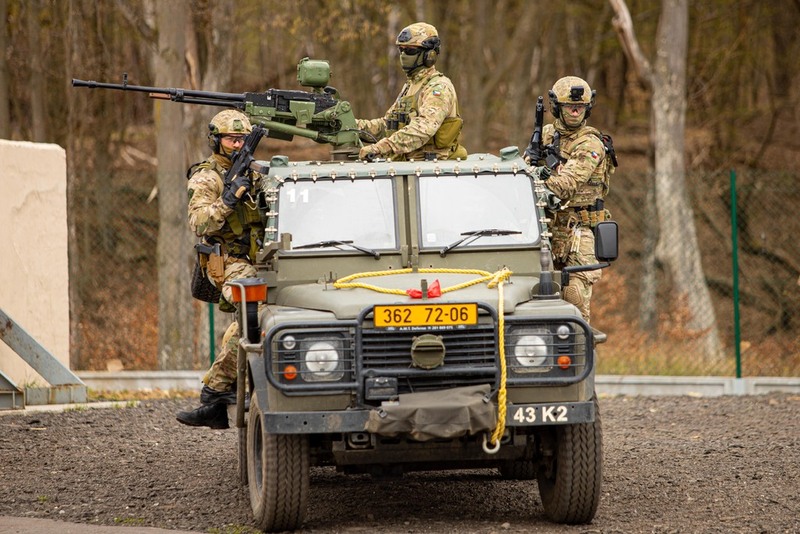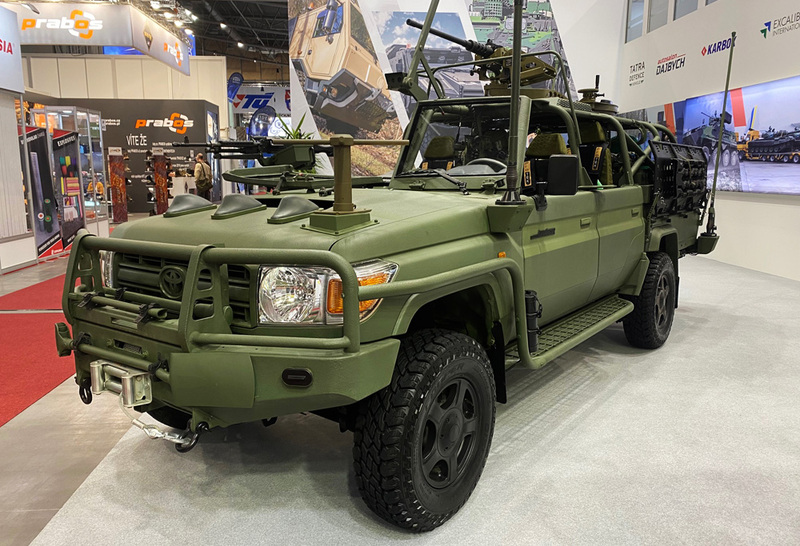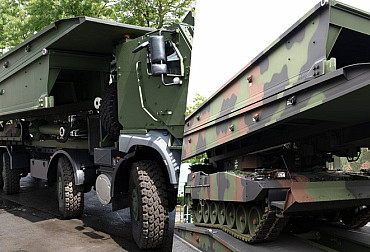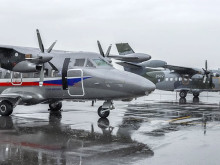The competition for the supply of light strike vehicles for paratroopers has been launched
The National Electronic Tool (NEN) for the administration and procurement of public contracts has recently published the long-awaited Light Strike Vehicle - Purchase, i.e. the procurement of Light Strike Vehicles (LUVs) weighing up to 9.5 tonnes, in the first phase for the 43rd Airborne Regiment, where the new vehicles will replace the outdated Land Rover Defender 130 Cayman. The Army requires transportability by Boeing CH-47 Chinook helicopter.
 Picture: The need for new Light Strike Vehicles for the Airborne Regiment is unquestionable. The LR Defender Cayman vehicles are old and have served their time. | 43rd Airborne Regiment
Picture: The need for new Light Strike Vehicles for the Airborne Regiment is unquestionable. The LR Defender Cayman vehicles are old and have served their time. | 43rd Airborne Regiment
In total, 159 units in six modifications (a total of 75 LUV-B combat vehicles, 27 command LUV-Vs with a capacity of 6+1, and 17 communications LUV-S, 18 Spike LR II ATGM carriers - LUV-PTŘS, 13 Expal M-86 mortar carriers - LUV-MIN, 9 reconnaissance LÚV-Pz with 4+1 capacity) including weapons equipment, 13 flatbed trailers (for LÚV-MIN) and ammunition, as well as procurement of spare parts and workshop equipment for maintenance and repair; accompanying and operational documentation; and training of designated persons, including the provision of training aids.
Deliveries are to be made in four stages: stage I by 15 October 2023 - one vehicle of each modification, stage II by 15 October 2024 (17 combat, 7 command, 4 communications, 8 ATGM carriers, 6 mortar carriers, 4 reconnaissance), stage III until 15 October 2025 (16 combat, 10 command, 7 communications, 4 ATGM carriers, 6 mortar carriers, 4 reconnaissance) and stage IV until 15 October 2026 (41 combat, 9 command, 5 communications and 5 ATGM carriers)
Vehicles delivered in Phase I will undergo inspection tests carried out by the Military Technical Institute in Vyškov and military tests at a designated unit. The vehicles, trailers and workshop equipment delivered will be subject to state quality verification.
 Picture: Long Range Patrol Vehicle (LRPV) - Gepard is based on the legendary Toyota Land Cruiser 70 series platform | Jan Zilvar / CZ DEFENCE
Picture: Long Range Patrol Vehicle (LRPV) - Gepard is based on the legendary Toyota Land Cruiser 70 series platform | Jan Zilvar / CZ DEFENCE
The following common requirements apply to all modifications:
„A vehicle with a 4x4 axle arrangement, open cab but with the possibility of configuring the crew protection against adverse weather conditions in cold climatic conditions, protected by a protective frame and with a payload of at least 2 000 kg is required. The LUV shall be equipped with a removable transport tarp. The characteristics of the vehicle shall enable the full-fledged combat operations of airborne forces and reconnaissance units, i.e. it shall ensure the transport of the required number of persons, enable the incorporation of weapons providing sufficient firepower and the implementation of modifications to the vehicle to ensure the required level of ballistic, mine protection and handling characteristics according to the parameters required below. The vehicle shall be designed in such a way that it is possible to modularly reconfigure its ballistic protection according to the current threat level, using only the vehicle crew's own forces and normal field workshop facilities.“
It also requires uniformity of the chassis, modularity of the ballistic protection system, comprehensive integration of armament, communication and information technologies and auxiliary equipment of airborne forces for independent performance of combat tasks outside the base for a minimum of 2 days, and a unified system of basic maintenance, repair and logistic support.
The technical specifications of the vehicles are not a surprise and are in line with how the plan has been presented so far (no later than March 2020, when the market survey was launched):
- Axle arrangement: 4 x 4
- Maximum length (mm): 6 500
- Maximum width (mm): 2 100
- Maximum transport height (mm): 1 900
- Maximum combat height (mm): 2 600
- Minimum approach angle - front: 40°
- Minimum approach angle - rear: 30°
- Minimum payload (kg): 2 000
- Maximum turning radius (m): 15
- Minimum maximum speed (km/h): 110
- Minimum road range (km): 700
- Minimum specific engine power at full operating load and with ballistic protection STANAG 4569, Ed. 3 Level 2: 24 kWt-1
- Maximum total weight - ballistic protection STANAG 4569, Ed.3 Level 2: 9 500 kg
- Vehicle electrical system: 24 V
- Minimum wading distance without preparation (mm): 700
- Minimum climbability: 55 %
- Minimum lateral inclination: 22°
- Transmission: Manual or automatic with manual override
The aforementioned 2020 market research resulted in 14 possible solutions from 12 of the 20 companies contacted. The list has not been officially published, but it is likely that the vehicles included vehicles from Israel (Plasan SandCat), Switzerland (MOVAG Eagle), the United States (Oshkosh JLTV), Saudi Arabia (Nimr SOV Mk2 Ajban), as well as the Czech Republic in the form of the Gepard from Toyota Dajbych or a vehicle being developed by Zetor. Highly debated and still matching the above parameters is the heaviest of the possible platforms: the HMT 400 4x4 Jackal vehicle from Supacat. The black horse of the competition may be the Flyer 72 from the American companies General Dynamics and Flyer Defense LLC, which is deployed in more than a thousand units by the Special Operations Command of the US Army (under the designation M1288 GMV 1.1), and which was on display at this year's NATO Days in Ostrava-Mošnov.
 Picture: Flyer 72 Heavy Duty Light Strike Vehicle | Michal Pivoňka / CZ DEFENCE
Picture: Flyer 72 Heavy Duty Light Strike Vehicle | Michal Pivoňka / CZ DEFENCE
The deadline for applications for participation is 8 November by 9:00. Following the possible exclusion of bidders who do not meet the required qualifications, the remaining bidders will be invited to submit bids. The ministry has so far worked with an estimated amount of CZK 5.5 billion.





















